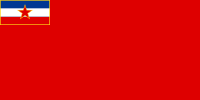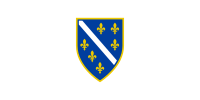Flag of Bosnia and Herzegovina: Difference between revisions
No edit summary |
Let's get the grammar right, guys... |
||
| Line 17: | Line 17: | ||
The '''flag of [[Bosnia and Herzegovina]]''' contains a wide medium blue vertical band on the fly side with a yellow [[isosceles triangle]] abutting the band and the top of the flag. The remainder of the flag is medium blue with seven full five-pointed white [[star (symbol)|star]]s and two half stars top and bottom along the [[hypotenuse]] of the triangle. |
The '''flag of [[Bosnia and Herzegovina]]''' contains a wide medium blue vertical band on the fly side with a yellow [[isosceles triangle]] abutting the band and the top of the flag. The remainder of the flag is medium blue with seven full five-pointed white [[star (symbol)|star]]s and two half stars top and bottom along the [[hypotenuse]] of the triangle. |
||
The three points of the triangle are understood to stand for the three constituent peoples of [[Bosnia and Herzegovina]]: [[Bosniaks]], [[Croats]], and [[Serbs]].<ref>http://www.independent.co.uk/news/outside-world-chooses-new-flag-for-bosnia-1142950.html</ref> It is also seen to represent the map of Bosnia and Herzegovina which looks like a triangle or a heart as some people call it the 'heart-shaped nation'. The stars, representing [[Europe]], are meant to be infinite in number and thus they continue from top to bottom. The flag features colors often associated with neutrality and peace - white, blue, and yellow. The colours yellow and blue are also seen to be taken from the [[flag of Europe]], the colour blue was originally based on the [[UN]]. The present scheme |
The three points of the triangle are understood to stand for the three constituent peoples of [[Bosnia and Herzegovina]]: [[Bosniaks]], [[Croats]], and [[Serbs]].<ref>http://www.independent.co.uk/news/outside-world-chooses-new-flag-for-bosnia-1142950.html</ref> It is also seen to represent the map of Bosnia and Herzegovina which looks like a triangle or a heart as some people call it the 'heart-shaped nation'. The stars, representing [[Europe]], are meant to be infinite in number and thus they continue from top to bottom. The flag features colors often associated with neutrality and peace - white, blue, and yellow. The colours yellow and blue are also seen to be taken from the [[flag of Europe]], the colour blue was originally based on the [[UN]]. The present scheme is being used by both the [[Council of Europe]] which owns the flag and the [[European Union]] which adopted the [[Council of Europe]]'s flag in 1985. They are also colours traditionally associated with Bosnia. |
||
==Historical flags== |
==Historical flags== |
||
Revision as of 03:29, 18 October 2009
 | |
| Use | National flag |
|---|---|
| Proportion | 1:2 |
| Adopted | February 4, 1998 |
| Design | A wide medium blue vertical band on the fly side with a yellow isosceles triangle abutting the band and the top of the flag; the remainder of the flag is medium blue with seven full five-pointed white stars and two half stars top and bottom along the hypotenuse of the triangle. |
| Designed by | Carlos Westendorp |

The flag of Bosnia and Herzegovina contains a wide medium blue vertical band on the fly side with a yellow isosceles triangle abutting the band and the top of the flag. The remainder of the flag is medium blue with seven full five-pointed white stars and two half stars top and bottom along the hypotenuse of the triangle.
The three points of the triangle are understood to stand for the three constituent peoples of Bosnia and Herzegovina: Bosniaks, Croats, and Serbs.[1] It is also seen to represent the map of Bosnia and Herzegovina which looks like a triangle or a heart as some people call it the 'heart-shaped nation'. The stars, representing Europe, are meant to be infinite in number and thus they continue from top to bottom. The flag features colors often associated with neutrality and peace - white, blue, and yellow. The colours yellow and blue are also seen to be taken from the flag of Europe, the colour blue was originally based on the UN. The present scheme is being used by both the Council of Europe which owns the flag and the European Union which adopted the Council of Europe's flag in 1985. They are also colours traditionally associated with Bosnia.
Historical flags
Tvrtko

Bosnia and Herzegovina has encountered constant flag changes throughout its history. One of the first recognized flags dates back from the Tvrtko reign in Bosnia. He used the coat of arms that many centuries later appeared on the Bosnian flag in 1991 and stayed on the Bosnian flag until 1998.
Western Herzegovina 1760 flag
The green flag with the white crescent and star pointing to the left was used by Bosniak landlords in border parts in southern and western Herzegovina. The flag was most commonly used in wars. It also accompanied Bosnian troops during the second siege of Hotin (Bukowina). It differs from Ottoman flag by size and direction of crescent, but also it is swallow-shaped, like some West-European jacks and ensigns.
Bosnian Revolt of 1830s flag
In the 1830s revolt by Husein Gradaščević the green flag with a yellow crescent and star was used. The revolt's aim was for Bosnia to gain autonomy from the Ottoman Empire.
Independent Bosnia 1878
In 1878 Bosnia existed briefly as an independent nation. Its flag was very similar to the flag used by Husein Gradaščević's revolt of 1830. It was green with a yellow crescent and star, but had more curvature to a typical Islamic crescent moon symbol. Bosnia was independent in 1878 for a few months, after the Ottoman troops left, but shortly afterward the Austro-Hungarians occupied Bosnia after an agreement reached in Berlin among major European powers. The green/golden flag was in use for about only two months.
Austro-Hungarian rule
When the Austro-Hungarian Empire annexed Bosnia and Herzegovina the flag was changed. The province of Bosnia used the flag that was red and yellow horizontally, but the province of Herzegovina used the same flag but reversed with reversed colors. (yellow and red).
The coat of arms is one of Stjepan Vukcic Hrvatinić, Bosnian noble and duke from 14th century. The original medieval coat of arms had a white background and two red stripes in the top of the shield.
-
 Flag of Bosnia during Austro Hungarian administration (the country was formally under the sovereignty of the Ottoman Empire) (1878 - 1908)
Flag of Bosnia during Austro Hungarian administration (the country was formally under the sovereignty of the Ottoman Empire) (1878 - 1908)
Yugoslav period

 Flag of the People's Republic of Bosnia and Herzegovina (1945 - 1991)
Flag of the People's Republic of Bosnia and Herzegovina (1945 - 1991)Bosnia and Herzegovina was one of the constituent republics of the former Yugoslavia. The flag of the Socialistic Republic of Bosnia and Herzegovina was very similar to Yugoslavia's old flag. It had the Yugoslav flag in the upper left corner, while the rest of the flag was red to symbolize the socialism and communism in Yugoslavia at the time. Bosnia and Herzegovina also had a new coat of arms during the Yugoslav period. It was a symbol of industrialism in Bosnia at the time.
Independent Bosnia 1992-1998

 Flag of the Republic of Bosnia and Herzegovina 1992-1998
Flag of the Republic of Bosnia and Herzegovina 1992-1998In 1992 Bosnia and Herzegovina gained its independence from Yugoslavia and a new flag. The flag has a white background with the Bosnian Fleur-de-lis in the center. The Bosnian Serbs and Bosnian Croats who lived in Bosnia-Herzegovina after the signing of the Dayton Agreement, viewed the flag as only representing the Bosniaks (formerly: Bosnian Muslims) of Bosnia-Herzegovina. The flag had to be eventually changed into the current day flag. The new flag was introduced by the UN High Representative after the Parliament of Bosnia-Herzegovina could not decide on a solution acceptable to all. The new flag contains no historical or other references to the Bosnian state.
Alternative flag variations (change of flag)
The first flag that was proposed in the First Set of Proposals was the "Czech Pattern", similar to the flag of the Czech Republic. It was intended to represent all three constitutive nations living in Bosnia and Herzegovina. The next proposal was the "Laurel branch". It is based on the light blue color of the United Nations Flag. It would have had a golden olive branch in the middle. The olive branch is taken from United Nations emblem. The flag would have only one branch. The branch was rotated around 30 degrees counterclockwise. The third proposal was the simplistic "Map" proposal. It would also use the United Nations light blue color; however, there would be the addition of a white outline map of Bosnia and Herzegovina. No official text was ever published specifying the color of the outline, but it probably would have been white.
The Second Set of Proposals had flags that were truly representative of Bosnia and Herzegovina as a whole. The first flag design was a diagonally striped tricolor pattern of red to white to blue (different colors but in the same pattern as the Flag of the Republic of the Congo). In the center there would be a blue map of Bosnia and Herzegovina outlined in yellow in the middle inside a circle of 10 five-pointed yellow stars. The flag would have been a 1:2 ratio. The second flag proposed was very similar except it had 12 five-pointed stars to represent the European Union. The European Union Flag has the 12 five-pointed stars. The third design was a bit more different from the first two designs. The diagonal tricolor shape was kept, but the diagonal white stripe was made wider so that the angle was not perfectly 45 degrees. In the center there was a yellow map of Bosnia and Herzegovina outlined in green and under it there were two green olive branches. The olive branch pattern was the same one that the United Nations uses in its flag. The final fourth design was kept the same emblem from the third design, but did not have the diagonal stripes. Instead it had a horizontal tricolor pattern of blue, white, and red (from top to bottom).
The first Westendorp alternative flag was a highly similar one to today's flag, a diagonally divided top-hoist to bottom-fly yellow over light blue flag with line of 10 white five-pointed stars in the light blue field along the diagonal. The only major difference was that the number of stars was 10. The second Westendorp alternative flag is a light blue flag (United Nations flag colors) with 5 bars interchangeably coming out of hoist and not reaching the other end. The colors are interchangeably yellow and white. In the third alternative flag, the field was light blue and had five narrow yellow bars.
Westendorp's decision ended up being the first alternative flag. However, it was changed slightly to a darker blue to symbolize the European Union's flag.
See also
- List of Bosnian and Herzegovinian flags
- Coat of arms of Bosnia and Herzegovina
- Flag of the Federation of Bosnia and Herzegovina
- Flag of Republika Srpska
- Flag of Kosovo
- Federation of Bosnia and Herzegovina
- Flag of European Union















